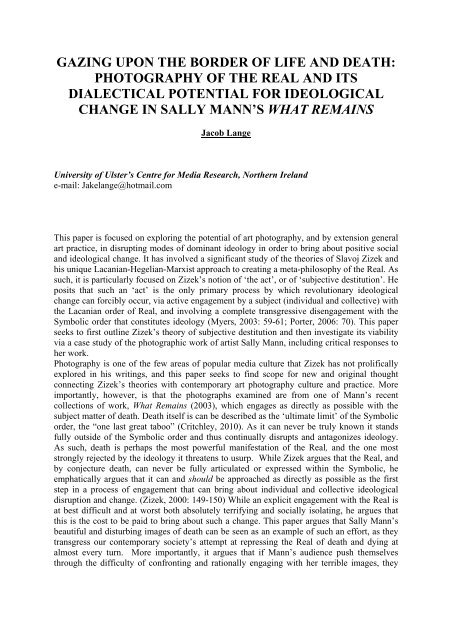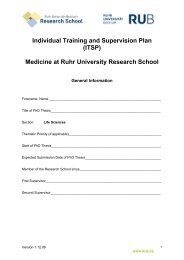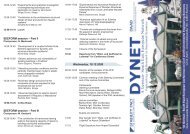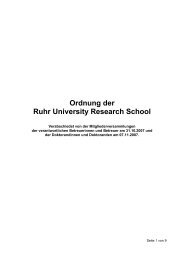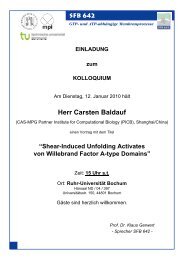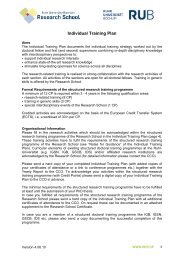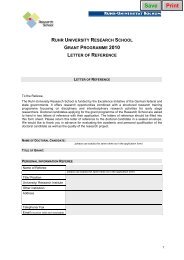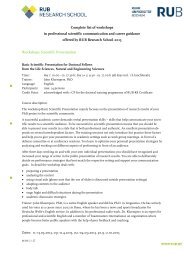Section Days abstract book 2010.indd - RUB Research School ...
Section Days abstract book 2010.indd - RUB Research School ...
Section Days abstract book 2010.indd - RUB Research School ...
You also want an ePaper? Increase the reach of your titles
YUMPU automatically turns print PDFs into web optimized ePapers that Google loves.
GAZING UPON THE BORDER OF LIFE AND DEATH:<br />
PHOTOGRAPHY OF THE REAL AND ITS<br />
DIALECTICAL POTENTIAL FOR IDEOLOGICAL<br />
CHANGE IN SALLY MANN’S WHAT REMAINS<br />
Jacob Lange<br />
University of Ulster’s Centre for Media <strong>Research</strong>, Northern Ireland<br />
e-mail: Jakelange@hotmail.com<br />
This paper is focused on exploring the potential of art photography, and by extension general<br />
art practice, in disrupting modes of dominant ideology in order to bring about positive social<br />
and ideological change. It has involved a significant study of the theories of Slavoj Zizek and<br />
his unique Lacanian-Hegelian-Marxist approach to creating a meta-philosophy of the Real. As<br />
such, it is particularly focused on Zizek’s notion of ‘the act’, or of ‘subjective destitution’. He<br />
posits that such an ‘act’ is the only primary process by which revolutionary ideological<br />
change can forcibly occur, via active engagement by a subject (individual and collective) with<br />
the Lacanian order of Real, and involving a complete transgressive disengagement with the<br />
Symbolic order that constitutes ideology (Myers, 2003: 59-61; Porter, 2006: 70). This paper<br />
seeks to first outline Zizek’s theory of subjective destitution and then investigate its viability<br />
via a case study of the photographic work of artist Sally Mann, including critical responses to<br />
her work.<br />
Photography is one of the few areas of popular media culture that Zizek has not prolifically<br />
explored in his writings, and this paper seeks to find scope for new and original thought<br />
connecting Zizek’s theories with contemporary art photography culture and practice. More<br />
importantly, however, is that the photographs examined are from one of Mann’s recent<br />
collections of work, What Remains (2003), which engages as directly as possible with the<br />
subject matter of death. Death itself is can be described as the ‘ultimate limit’ of the Symbolic<br />
order, the “one last great taboo” (Critchley, 2010). As it can never be truly known it stands<br />
fully outside of the Symbolic order and thus continually disrupts and antagonizes ideology.<br />
As such, death is perhaps the most powerful manifestation of the Real, and the one most<br />
strongly rejected by the ideology it threatens to usurp. While Zizek argues that the Real, and<br />
by conjecture death, can never be fully articulated or expressed within the Symbolic, he<br />
emphatically argues that it can and should be approached as directly as possible as the first<br />
step in a process of engagement that can bring about individual and collective ideological<br />
disruption and change. (Zizek, 2000: 149-150) While an explicit engagement with the Real is<br />
at best difficult and at worst both absolutely terrifying and socially isolating, he argues that<br />
this is the cost to be paid to bring about such a change. This paper argues that Sally Mann’s<br />
beautiful and disturbing images of death can be seen as an example of such an effort, as they<br />
transgress our contemporary society’s attempt at repressing the Real of death and dying at<br />
almost every turn. More importantly, it argues that if Mann’s audience push themselves<br />
through the difficulty of confronting and rationally engaging with her terrible images, they


